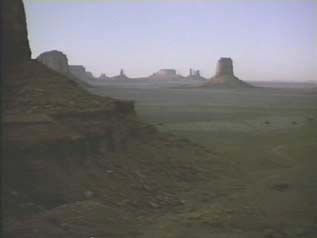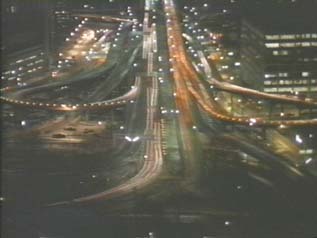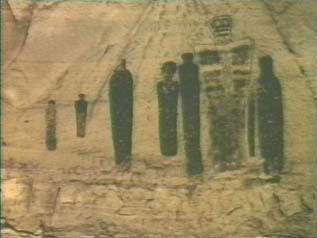 As many participants know, the annual Computers & Writing Conference provides good ideas for our classrooms and research. At the 2000 conference in Florida, a group of us sat in a hallway excited about a film we had just watched, the documentary Fast, Cheap, and Out of Control. It seemed to us that consideration of cutting-edge film could become more than a single screening, an after-hours diversion during the conference. We agreed that many recent films incorporated elements of hypermedia in their sensibilities, even composition. An obvious example was the 2000 feature film Time Code, confronting the viewer with four separate stories presented simultaneously via a four-way split screen.
As many participants know, the annual Computers & Writing Conference provides good ideas for our classrooms and research. At the 2000 conference in Florida, a group of us sat in a hallway excited about a film we had just watched, the documentary Fast, Cheap, and Out of Control. It seemed to us that consideration of cutting-edge film could become more than a single screening, an after-hours diversion during the conference. We agreed that many recent films incorporated elements of hypermedia in their sensibilities, even composition. An obvious example was the 2000 feature film Time Code, confronting the viewer with four separate stories presented simultaneously via a four-way split screen.
Other examples came to mind, and we began to lay plans for the following year's conference, where Cindy Selfe chaired "Representations of Technology in Film and New Media," a panel in which several presenters explored how computer technology, new notions of literacy, and video collide and recombine, like some genetic experiment run wild, into forms shockingly new. Sharon Cogdill explored the interiorizing of technology in popular cinema and television: Max Headroom, Edward Scissorhands, even those vaguely disquieting Teletubbies. Michael Keller, of Virginia Commonwealth University, noted how hypermedia had itself become cinematic, something he demonstrated at C&W 2001 with sites by Eric Rodenbeck, while Erin Smith dazzled conferees with the combined text and Flash technology of the eneriwoman Project.
Beginning with our talk in the hallway, one avant-garde documentary, Godfrey Reggio's 1982 film Koyaanisqatsi, kept coming to mind as prefiguring modern hypermedia. It became my subject at CW 2001. The film has haunted me for years, partly because of its stunning cinematography, partly for the environmental message that became part of my awakening as an activist, and partly for its sound track, seventeen pieces of music in five movements by Philip Glass.
Love or hate Glass' music, the viewer cannot escape its effect of tying together Reggio's use of montage. The leitmotifs--some of them strident, others placid--set the tone for various sequences and for Reggio's raising questions about how technology alters the natural landscape and the human psyche. All this, by the way, in a documentary that has only a single spoken word: Koyaanisqatsi, a Hopi term translated as "Crazy life, life in Turmoil, life out of Balance, life disintegrating, a life that calls for another way of living." Hello. As the Hopi with whom Reggio had lived told him, the world outside their mesa was "insane" and they offered a chilling ancient prophecy for the end-times:
Near the day of purification, there will be cobwebs spun back and forth in the sky. A container of ashes might one day be thrown from the sky, which could burn the land and boil the oceans.
Reggio's philosophical influences include Jacques Ellul and Louis Mumford, but as a film-maker he takes Sergei Eisenstein's concept of montage to a profound level, connecting shots and sequences of film to examine issues of clock-time versus nature's cyclic rhythms and the overcrowding of the human-centered landscape. Most memorably, Reggio confronts viewers with the possibility that the Hopi prophecy will come true, and the hurly-burly of postmodern living will end as surely as other destructive events he films. Reggio documents canyons filled to make lakes, mountains leveled to make mines, old vehicles bombed to atoms on target ranges, and square miles of abandoned housing projects dynamited to make urban brown-fields. This message has not lost its potency. In fact, the images of planned demolitions in big cites are currently too close to home, given events that unfolded as I completed this article. As a result, I will not show the film this semester to students still traumatized by the terrorist attacks. Many of my students come from the greater New York City area, and Reference List Birkerts, S. (1995). "Digital refusnik." Retrieved September 1, 2001, from Wired magazine: http://www.wired.com/wired/archive/3.05/refusnik_pr.html. eneriwoman site (2001). Retrieved September 6, 2001, from http://www.eneri.net. Institute for Regional Education (2001). Retrieved September 2, 2001, from http://www.koyaanisqatsi.org. Landow, G. (1997). Hypertext 2.0. Baltimore: Johns Hopkins. Rodenbeck, Eric (2001). Retrieved September 2, 2001, from http://www.trench.com/erode/p/main.html. I would like to thank the Larry Taub of the IRE for permission to reproduce the still images used in this article.
 one of them lost the parent of a friend in the bombings.
one of them lost the parent of a friend in the bombings.
It is difficult but not impossible to find some solace amid the uncertainty here. One positive aspect of Reggio's warnings comes from the changing nature of the threat posed by various technologies. In 1982, to this viewer, the end-game seemed as close as one mistake in the Pentagon or Kremlin. Today, the ten-headed beast of a MIRV warhead has yielded to billions of car exhausts and power plants steadily pumping CO2 into the sky. Even the fingers on the keyboard typing this become accomplices in climate change and other forms of environmental degradation, since the computer is part of a complex of energy that embraces coal-fired power, mining, planned obsolescence, and socioeconomic inequities. In this, however, lies a crucial difference and a way of empowering ourselves as technology users. As accomplices rather than Cold-War spectators and potential targets, we who use questionable technologies have more power to shape and alter their application and consequences.
One might guess that I'm about to pick up Sven Birkerts' mantra of "refuse it" and head for my Montana cabin. Not quite. As Birkerts (1995) noted in an interview for Wired, his goal as a Luddite has been to encourage others to think about, not completely spurn, the web of technologies we so readily embrace. This has been Reggio's goal as well, and in creating films to this end Reggio and cinematographer Ron Fricke created their own technological prophecy.
Reggio, apparently without knowledge of early hypertext systems or the looming cultural shift that the Web would bring, created video that included several features we have come to associate with hypertext: a structure that resembles lexia and links, key scenes that in effect serve as  many-to-one links, other scenes that resemble "push" pages. The structure of the film resembles Landow's (1997) model for "axial hypertext," a model that employs not an open-ended network structure but a fairly linear arrangement typified by annotated texts and online encyclopedias. Reggio, who has made repeated claims that he wants to raise questions rather than indoctrinate his audience, uses the axial model well. Viewers watch events as they move along an axis of ever-more-controlled environments, starting with scenes of cave-paintings engulfed in a fireball--the first of several such apocalypses--images of nature ever more firmly under human control. Each sequence ends with apocalyptic change that led me, in 1982 and today, to the inexorable conclusion that our civilization, too, faces a similar fate unless we reconsider our relationship to the land and its resources. All along, the filmmaker brings to the foreground the reconfiguring of human life into a network of managed activities and time. We all move in patterns ordered by our technology, like Reggio's time-lapse footage of night traffic, the making of hot-dogs, and the movement of commuters through Grand Central Station.
many-to-one links, other scenes that resemble "push" pages. The structure of the film resembles Landow's (1997) model for "axial hypertext," a model that employs not an open-ended network structure but a fairly linear arrangement typified by annotated texts and online encyclopedias. Reggio, who has made repeated claims that he wants to raise questions rather than indoctrinate his audience, uses the axial model well. Viewers watch events as they move along an axis of ever-more-controlled environments, starting with scenes of cave-paintings engulfed in a fireball--the first of several such apocalypses--images of nature ever more firmly under human control. Each sequence ends with apocalyptic change that led me, in 1982 and today, to the inexorable conclusion that our civilization, too, faces a similar fate unless we reconsider our relationship to the land and its resources. All along, the filmmaker brings to the foreground the reconfiguring of human life into a network of managed activities and time. We all move in patterns ordered by our technology, like Reggio's time-lapse footage of night traffic, the making of hot-dogs, and the movement of commuters through Grand Central Station.
The use of these techniques in a documentary film, albeit a very non-traditional documentary, creates a real opportunity for teachers working in networked environments. First, many of us now have some digital-video-editing equipment nearby, so we can dissect digitized moments from film to see how transitions, score, and subliminal images work together as elements of composition. For instance, viewers watch a barrage of television clips that Reggio splices together in one segment of his film. With DV software, the viewer can isolate this segment and unpack each frame to reveal: images of televangelists and exotic dancers; American politicians, then a swastika; car chases and bomb-runs;  Thomas Dolby singing "She blinded me with science" followed by a dead-end sign. What dazzled the viewer at full gallop suddenly becomes obvious and heavy-handed at a crawl. We see Reggio's fascinations with some of most banal aspects of popular culture played out, and then it becomes much easier for students to relate these images to the filmaker's larger concerns.
Thomas Dolby singing "She blinded me with science" followed by a dead-end sign. What dazzled the viewer at full gallop suddenly becomes obvious and heavy-handed at a crawl. We see Reggio's fascinations with some of most banal aspects of popular culture played out, and then it becomes much easier for students to relate these images to the filmaker's larger concerns.
Perhaps we can truly begin to escape the boundaries of printed composition by studying a few films with our writing students. Writers could compare this hypertextual piece of film to linear printed and hypertextual works.The structure of Reggio's film, and the potential to deconstruct it for writing projects, could lead writers toward media-rich hypertext that embraces video, music, and social consciousness. These are potentials that can only be hinted at here, but the trajectory of the tools in our classrooms is clear, arching toward a complete integration of several media formats (mostly, and tellingly, forced before us by Microsoft). This question, like those Reggio raises, will not vanish easily but can become an occasion for discussion and resistance.
The film, and the ability to make bricollage of it and other scraps, can lead students in directions as exciting as those pursued by Eric Rodenbeck or the woman who authored the eneriwoman site. Incidentally, she has pulled the site from public access--only a mysterious image and the words "I need to hide for a while until you completely forget about me" remain. Did she get discovered by the Academy? Get too many e-mail requests for dates? This too becomes a question for our classrooms. Like the cobwebs in the sky of the prophecy, it hangs in the air daily as we make attempts, often futile, to hide from the intrusions of networked life.
Sadly, Reggio's film is now hard to find, not in release because of legal issues involving the multinational that currently owns the rights. A nonprofit organization, the Institute for Regional Education, does press limited-edition DVDs with Glass' remixed score. A re-release in a larger edition seems likely after the IRE gets its day in court. Conferences such as C&W can help revive interest in this film and similar works that don't often show up in cineplexes. In a larger sense, however, looking at work by Reggio and other innovators with nontextual media will enrich our classrooms; our students know the language of video in their bones, and we do well to learn this second language.
Meanwhile, Koyaanisqatsi persists as a cult film, and the many surviving VHS copies available enable teachers to harness its power for starting discussions about and the ways in which the visual and textual are becoming fused in new forms of writing. It is my hope to push that discussion into another area: the unintended consequences of technology, even the seemingly harmless technologies of the writing classroom. My spell-check keeps trying to turn Reggio's first name into "gadfly," and as such he has done a masterful job with his film.